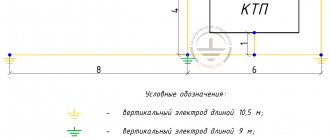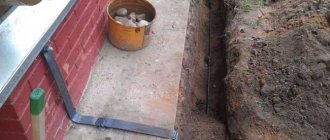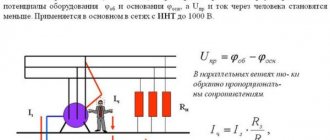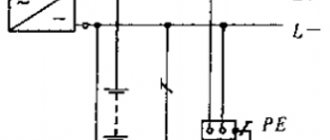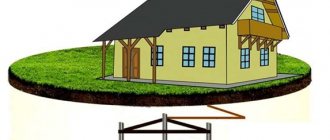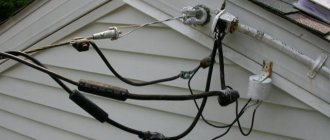Preventative work
The rules for the technical operation of consumer electrical installations, better known by the abbreviation PTEEP, provide for the prevention and repair of grounding. In order to determine whether outside intervention in the pipeline ground loop is necessary, maintenance personnel perform the following measures:
- For overhead communications, a visual inspection of the accessible part is carried out.
For underground communications, inspection is carried out by opening the soil.
Explosive areas
Some industrial plants are partially or entirely explosive because they use or produce flammable substances. But here’s what’s interesting here: in the process of physical friction of the liquefied substance against the walls of the pipes, natural grounding is created, but this, unfortunately, is not enough for safety. Therefore, in such cases, additional grounding is installed in some areas, using a wire without metal insulation, for example, an AAShV power cable, where aluminum wires in impregnated paper insulation are enclosed in a polyvinyl chloride sheath.
How to use this knowledge at home
Perhaps someone will ask themselves, why do I need such information if I’m not doing this? Well, such a person will be right, because at home there will be no need to ground process pipelines. But such a statement will be shaken if you look at the situation from the other side.
Zeroing the socket
In old houses built during the times of I. Stalin and N. Khrushchev, no grounding of any communications is provided. Therefore, some residents encountered problems such as a “breaking” washing machine or a “breaking” mixer. In both cases, the reasons are similar: a bare phase wire has come into contact with the ground.
Video description
TOP 10 mistakes in installing the Grounding device.
In the private sector
Grounding loops in the private sector can be made in different ways and this is a topic for a separate article, but here we will look at the basic principles of such a device. In most cases, a triangle is made, where a steel corner 50X50 mm or reinforcement Ø 10-14 mm is used as pins. They are welded together either with wire rod or a 20X5 mm steel strip at a distance of a meter. The approximate depth is from 2 to 3 meters, but this depends on the soil. The strip is carefully welded to the pins - the seam must only be of high quality.
Now, the most important thing: take the tester in your hands and measure the resistance between the two pins - it should not be more than 4 Ω, but the strip or wire from the house to the circuit should not be more than 0.1 Ω. In this case, you will never get an electric shock in the toilet, bathroom or kitchen when you use the water supply or sewer system.
LLC Svoy Master & PoliStyle
February 07, 2020
PUE in questions and answers. Grounding
Grounding devices for electrical installations with voltages up to 1 kV in networks with a solidly grounded neutral
Where should the grounding conductor be connected if a CT is installed in the PEN conductor connecting the neutral of the transformer or generator to the PEN bus of the switchgear up to I kV?
Answer. It should not be connected directly to the neutral of the transformer or generator, but to the PEN conductor, if possible directly to the CT. In this case, the division of the PEN conductor into RE and N conductors in the TN-S system must also be carried out behind the CT. The CT should be placed as close as possible to the neutral terminal of the transformer or generator.
What should be the resistance of the grounding device to which the neutrals of a generator or transformer, or the terminals of a single-phase current source are connected?
Answer. There should be no more than 2, 4 and 8 Ohms at any time of the year, respectively, at 660, 380 and 220 V three-phase current source or 380, 220 and 127 V single-phase current source. This resistance must be ensured taking into account the use of natural grounding conductors, as well as re-grounding conductors of PEN or PE conductors of overhead lines up to 1 kV with a number of outgoing lines of at least two.
What should be the resistance of the ground electrode located in close proximity to the neutral of a generator or transformer, or the output of a single-phase current source?
Answer. There should be no more than 15, 30 and 60 Ohms, respectively, at line voltages of 660, 380 and 220 V of a three-phase current source or 380, 220 and 127 V of a single-phase current source. If the earth resistivity is ρ > 100 Ohm×m, it is allowed to increase the specified standards by 0.01 ρ times, but not more than tenfold.
At what points in the network should the PEN conductor be re-grounded?
Answer. Must be performed at the ends of overhead lines or branches from them with a length of more than 200 m, as well as at the inputs of overhead lines to electrical installations in which automatic power off is used as a protective measure in case of indirect contact.
What should be the total resistance to spreading of grounding conductors (including natural ones) of all repeated groundings of the PEN conductor of each overhead line at any time of the year?
Answer. There should be no more than 5, 10 and 20 Ohms, respectively, at line voltages of 660, 380 and 220 V of a three-phase current source or 380, 220 and 127 V of a single-phase current source. In this case, the spreading resistance of the grounding conductor of each of the repeated groundings should be no more than 15, 30 and 60 Ohms, respectively, at the same voltages. If the earth resistivity is ρ > 100 Ohm×m, it is allowed to increase the specified standards by 0.01ρ times, but not more than tenfold.
Do pipelines need to be grounded? and how can this be done?
According to GOST R 505 71 (M EK 364), grounding and grounding of pipelines must be carried out for all metal circuits associated with electrical installations > ≈ 42 V or > - 11V. For alternating and direct currents less than the specified values, grounding is not necessary. In fact, what we constantly encounter in life is somewhat larger than these numbers, therefore, it never hurts to know the instructions for installing grounding.
Such structures are grounded regardless of the material they are made of.
What the Electrical Installation Rules say
According to the Electrical Installation Rules, any technological equipment (including pipelines) must be grounded. Otherwise, the entire facility as a whole cannot be allowed to operate (grounding of pipelines PUE 1.7).
- A metal connection is provided along the entire length of the pipe circuit, regardless of the purpose and technical features of the laying.
- The grounding circuit is selected in accordance with the temperature of the material and the resistivity (denoted by ρ) of the soil at the installation site.
- The structure (above or underground) must be grounded at least at two points along its entire length.
- All communications along the path of the circuit must also be grounded. For example, all residential buildings connected to centralized heating, water supply and sewerage, even if the wiring in the buildings is made of PVC, PE, PPR.
Recommendation: if your house or apartment has water supply, sewerage and heating pipes made of PVC, PE and PPR, then the faucets in any case remain metal. When an electric boiler or washing machine goes to ground, all the taps of both you and your neighbors will be shocked. To prevent this from happening, adhere to PUE 1.7.76 (published below).
Next, we will briefly consider the grounding of pipelines according to paragraphs of PUE 1.7.
Clause 1.7.76
Protection against contact with the above-ground and root systems of trees applies to:
- enclosures: electrical machines, transformer substations, electrical supports, etc.;
- electric drives (for example, barriers, switches);
- electrical panel frames of any type;
- any metal structures of distribution devices, cables, couplings, hoses/pipes of electrical wires, etc.;
- metal cable sheaths, as well as pipes, boxes, trays, etc.;
- housings of mobile/portable electrical receivers;
- electrical equipment on moving parts of machines and mechanisms.
All of the above devices and installations must be connected to a common solidly grounded neutral in the system.
Clause 1.7.77
Connection to the neutral of the grounding system is not provided:
- housings of any electrical equipment installed on grounded platforms;
- all structures that have reliable contact with other grounded equipment;
- all removable or opening parts of equipment not exceeding ≈ 42 V or - 11 V (Clause 1.7.53);
- power line fittings and insulators;
- open conductive elements with double insulation;
- all metal fasteners with a total area of no more than 1 m2.
1.2. Requirements for a protective grounding system
1.2.1. In underground mine workings, a common grounding network must be installed, to which all objects to be grounded must be connected.
The resistance of the grounding device used for electrical installations of various voltages must meet the requirements for grounding electrical installations that require the lowest resistance of the grounding device.
1.2.2. For intrinsically safe telephone communication equipment and its cable couplings, in a network section with cables without armor, local grounding is allowed without connection to the general grounding network. The resistance of this independent grounding must be taken such that the product of the active resistance of the grounding and the fault current flowing in it does not exceed the permissible value of the safe touch voltage.
1.2.3. The main grounding circuit and grounding loop must be made of bare steel conductor with a cross-section of at least 100 mm2. Conductors must be placed so as to prevent mechanical damage or corrosion (especially at their connection points) and so that they can be monitored.
1.2.4. The main grounding circuit must have at least two main artificial grounding conductors located in different places.
1.2.5. When calculating, the grounding resistance should be taken such that the touch voltage on electrical installation housings during a ground fault does not exceed the permissible value according to GOST 12.1.038, but not more than 2 Ohms.
Pipe stands
Let's start with the fact that pipe stands, as a concept according to the PEU, do not play any role in the grounding of technological main pipelines, despite their cognate sound. Pipe stands are used for installation of insulated power wires (SIP) and their connection to switchboard units (CPU). These same boards can serve as distribution boxes for any objects (houses, power lines, pumping and boiler stations, etc.). In fact, even if the distribution from the transformer goes to a pumping station serving a centralized or autonomous water supply system, then PUE 1.7.76 on the grounding of electrical appliances and installations is triggered there.
Note: the pipe stand is not always made of pipe - it can also be a hollow profile with a square/rectangular cross-section, a steel angle or a channel.
Explosive areas
Taking into account the design and purpose, we can distinguish:
- oil pipelines and gas pipelines;
- systems through which alcohol-containing liquids/gases are transported.
Transportation of explosive and fire hazardous substances imposes increased safety requirements. The standards are described in the PUE (chapter 7.3).
In the case of explosive premises, the use of natural grounding conductors is permissible only if they provide additional protection. The main one should be an artificially constructed circuit.
Installation features
Some grounding connections of the finished pipeline (at least many of them) will differ from each other, and this is not at all because the electricians do not comply with the PUE. The fact is that the operating conditions of such structures can be fundamentally different from each other.
Grounding of process pipelines that are installed directly in the building (basement) is carried out using an artificial building circuit intended for all technological electrical equipment that is there.
All pipes are grounded using this principle.
The grounding unit for a pipeline in buildings is done as follows: a metal clamp is welded or thrown onto the pipe, on which there is a mounting hole for a bolt with a nut and washer, which serves as a terminal for the circuit. All contact points, without exception, such as the pipe walls, clamp, terminal bolt with nut and washer, must be thoroughly cleaned and pressed tightly against each other to avoid oxidation and corrosion.
The cross-section of the ground loop, depending on the object, should be as follows:
- copper without mechanical protection: ≥ 4.0 mm2;
- copper with mechanical protection: ≥ 2.5 mm2;
- aluminum: ≥ 16.0 mm2.
In terms of the number of ohms, the circuit, taking into account the line voltage, should be:
- for three-phase power lines with a voltage of 220/380/660 V corresponds to 5/10/20 Ω;
- for single-phase power lines 127/220/380 V corresponds to 5/10/20 Ω.
Effect of insulation on pipelines
It is noteworthy that the grounding of metal pipelines, or more precisely, the quality and duration of their service life, is affected by the insulation of autonomous and centralized pipelines. The fact is that when installing a pipeline, the layer, first of all, cares about reducing heat losses, or about its integrity, therefore, all materials used for this purpose have low water permeability. When the structure is underground, there is almost no oxygen there, plus protection from moisture equals very slow corrosion of the metal, and the less it is, the longer all contacts of the circuit will remain constant.
For grounding pipelines above ground (heating mains, gas pipelines), similar methods and materials are used, only here thin film polymers and paint are the best protection against corrosion. For example, for heat pipes, polyethylene film with an external bitumen coating or polyurethane foam coating is often used (the second option is more expensive). But gas comes to our apartments through pipes that are simply painted, since methane (CH4) does not react to negative temperatures, therefore, does not need insulation. But in both cases there is anti-corrosion protection that is favorable for ground loops.
Why is it better not to ground to the water supply?
The whole problem is the human factor and the fact that we don’t know where it will work. Nowadays, most apartment owners are switching from metal water supply to polypropylene or metal-plastic. That is, when connecting the grounding to the pipe, we cannot know whether there is still a metal pipeline underneath us or whether at least part of it has been replaced with polypropylene. Previously, such a problem did not exist - in fact, like plastic pipes.
By grounding equipment to the water supply, we can endanger our lives and the lives of our neighbors. If the insulation breaks down, a phase may appear on the pipe. Once you touch the pipe, an electric shock is guaranteed.
Preventative work
The rules for the technical operation of consumer electrical installations, better known by the abbreviation PTEEP, provide for the prevention and repair of grounding. In order to determine whether outside intervention in the pipeline ground loop is necessary, maintenance personnel perform the following measures:
- For overhead communications, a visual inspection of the accessible part is carried out.
- For underground communications, inspection is carried out by opening the soil.
- For both types, control measurements are performed to verify compliance with standards.
How to use this knowledge at home
Perhaps someone will ask themselves, why do I need such information if I’m not doing this? Well, such a person will be right, because at home there will be no need to ground process pipelines. But such a statement will be shaken if you look at the situation from the other side.
Zeroing the socket
In old houses built during the times of I. Stalin and N. Khrushchev, no grounding of any communications is provided. Therefore, some residents encountered problems such as a “breaking” washing machine or a “breaking” mixer. In both cases, the reasons are similar: a bare phase wire has come into contact with the ground.
To ground, you need to bridge the neutral terminal with the ground terminal
If the faucet breaks, it means that it is enough to reverse the polarity of the common wire that goes to the bathtub. If the washing machine is beating, you need to zero the socket. To do this, open the cover of the device where the unit is turned on, find the zero terminal (the indicator on it does not light up) and bridge it with one of the ground terminals. A good jumper will be made from an insulated copper wire with a cross section of 0.5-1 mm2. After this, the machine and the metal sewer will stop beating.
Copper wire
Practice shows that the most popular method by which pipelines are grounded is the use of copper wire. It is recommended to use wire with a diameter of 1...1.5 mm.
It is carried out both from the inside and from the outside, fastening it together at the joints using a wire jumper. The cold soldering method is used for connection. The outer wire installed at the end point needs to be carefully grounded.
Grounding the pipeline is the simplest, but at the same time mandatory, method of removing accumulated static charges of electricity. The main measure that prevents the occurrence of discharges accompanied by a spark is grounding with full shunting of taps and couplings.
The operation is performed using copper wire.
It is worth noting that the use of grounding technology in water pipes can significantly reduce the potential between the walls and the liquid itself, which is transmitted through it. However, no grounding system can completely eliminate the electrification of liquid substances.
In the private sector
Grounding loops in the private sector can be made in different ways and this is a topic for a separate article, but here we will look at the basic principles of such a device. In most cases, a triangle is made, where a steel corner 50X50 mm or reinforcement Ø 10-14 mm is used as pins. They are welded together either with wire rod or a 20X5 mm steel strip at a distance of a meter. The approximate depth is from 2 to 3 meters, but this depends on the soil. The strip is carefully welded to the pins - the seam must only be of high quality.
Now, the most important thing: take the tester in your hands and measure the resistance between the two pins - it should not be more than 4 Ω, but the strip or wire from the house to the circuit should not be more than 0.1 Ω. In this case, you will never get an electric shock in the toilet, bathroom or kitchen when you use the water supply or sewer system.
Effect of insulation
The insulation resistivity indicator can significantly influence the characteristic features of the pipeline. According to studies, the level of resistance in the grounding of a pipeline using bitumen insulation can greatly depend on the potential difference between the soil and the pipeline itself.
If the difference varies within a few hundred volts, glow discharge may occur at defective locations, which in turn reduces the ground resistance. If the potential difference is one kilovolt or more, an arc discharge appears between the soil and the pipeline.
It, accordingly, greatly reduces the resistance of the installed grounding. Portable grounding can also be used, in which the clamp is the main part.
Source
Grounding of pipelines
During operation, pipeline networks experience mechanical, chemical, and temperature loads. Underground sections of the line are exposed to static electricity accumulated in the ground. Pipes that are laid above ground are affected by atmospheric electrical discharges and can also be struck by lightning. To protect consumers and service personnel of the branch from static electricity, the main line is grounded. The procedure effectively prevents the negative impact of electrical discharges on transported materials.
The term “grounding electrode” refers to a metal conductor that is in direct contact with the ground.
Protection against static electricity. Emergence and action
Static electricity occurs due to the retention of charges in an electrostatic field on dielectric materials. It negatively affects human life and the operation of electrical devices. The formation of sparks from static electricity contributes to fires and explosions. The energy power is quite enough to ignite gas-air mixtures and dust.
A charge of static electricity can accumulate on a person's body if he is wearing clothing made of wool or chemical fibers. A potential value of about 7 Joules is not dangerous to humans, but can cause cramps and muscle contractions. And this, in turn, can create conditions for injury at work, falling from a height, etc.
Static electricity negatively affects the functioning of precision instruments, radio communications, and causes malfunctions. Workers who are constantly exposed to static electricity are more likely to suffer from cardiovascular diseases and diseases of the nervous system.
Only protection against static electricity can reduce to zero or completely prevent the occurrence of this negative phenomenon.
Sources of static electricity
- Action of various radiations.
- Sudden change in temperature.
- The interaction of bodies with each other during movement.
This phenomenon has a negative impact and poses a danger. Protection against static electricity allows you to completely prevent or significantly reduce its effect.
In everyday conditions, a static field often occurs on animal fur, when removing synthetic clothing, combing hair, wearing rubber shoes, walking on a carpet in wool socks, or using plastic products.
The electrostatic field does not threaten human life; the discharge produces a weak current that is not capable of causing too much harm to the human body. It can only create some discomfort. To prevent this effect, you only need to follow a few simple rules: in frosty and dry weather, do not pet animals, take off woolen clothes more slowly, or treat them with a special compound, and use a wooden or metal comb when combing your hair.
The accumulation of electrostatic energy is facilitated by:
- Reinforced concrete walls of the building.
- The air is too dry.
For electronic devices, electrostatic charge is the worst enemy. Some elements of electronic devices are not able to withstand the high voltages that occur during discharge. Sensitive elements may fail or degrade their performance.
If flammable liquids are exposed to an electric field, this will create conditions for their ignition. These liquids may accumulate a static charge when transported in tanks. Also, a charge arises from a mechanism or a person who comes close to it. Therefore, in industrial production, where there are flammable liquids, much attention is paid to the grounding of movable structures and mechanisms. For sewing shoes and special clothing, production also uses special fabrics that are not capable of accumulating an electric charge.
PUE rules
In Russia, there is a document “Rules for the Construction of Electrical Installations”, which regulates methods of protecting external and internal engineering facilities from dangerous charges. It states that these procedures must be completed before putting process pipelines into operation. Thanks to this, a level of safety is ensured during repair work and laying the route.
All types of internal communications are grounded at the points of entry into the structure. For example, this also applies to heating lines in residential buildings. They can also carry current and pose a danger to others.
So, what are the requirements for the systems?
- it is important to ensure a constant metal connection (continuous electrical circuit) along the entire length of the communication;
- the type of grounding loop must correspond to the resistivity of the soil in the installation area and the spreading current of the installation;
- the route is connected to the grounding loop in several places (at least two points). The exact number of such points depends on the technical characteristics and the length of the highway.
Copper wire
One of the most popular methods of protection is the installation of copper wire or conductor on the outside and inside of the line. They form a continuous electrical network. Jumpers are installed on routes that include flange connections.
Copper wires of the PVZ or PuGV brands are used as the basis for the wire. The wire diameter is usually from 1 to 1.5 mm. Special tips are fixed at the ends of the wire by pressing. Wafer jumpers are secured to the pipe itself with bolted fasteners. Sometimes the cold soldering technique is used for connection.
Pipe stands
With their help, they install an input device into a private country house or administrative building. The purpose of the pipe stand is to fix the installation of the shield itself and the power wires that lead to it.
The PUE indicates that a metal pipe stand must be grounded. They protect not only it from current, but also the shield, the zero bus. When performing the operation, select a green-yellow wire PV-3 with tips.
Explosive areas
Gas, alcohol-containing liquids and other fire hazardous products are often transported along highways. How are explosive areas protected during the construction of oil and gas pipelines?
Firstly, the safety standards required to be observed are contained in the “Rules for the Construction of Electrical Installations”. Secondly, natural grounding agents are used. These include:
- metal structures of buildings and structures that go deep into the ground;
- underground communication systems made of metal (for example, wells, sewers, water pipelines). But underground objects can be used as a natural grounding conductor only if its pipe sections have been connected by electric or gas welding. The PUE prohibits the adaptation of gasoline, gas, and oil pipelines for these purposes.
When explosive workshop premises are located on the territory of large production facilities, specialists are faced with the task of high-quality removal of static electricity. It occurs when friction occurs under the pressure of a liquid substance against the wall of a steel pipe. An effective measure to reduce potential carryover is the use of cable conductors with a non-metallic sheath (for example, AAShV brand).
Regulations
The established requirements regulate the procedure for organizing the heating system for each type of boiler, its power and location.
The most commonly used equipment is one that runs on natural gas. This is due to its high performance and low cost of use. The design and method of operation allow it to be used also in public buildings.
SNiP II-35-76 standards determine the installation conditions for boilers operating on solid fuel. Electric boilers are installed in accordance with PUE standards.
These documents set out the requirements for the design of the heating system. In addition to them, there are many other heating units that regulate certain aspects during construction.
Rules and regulations for installing a gas boiler in a private house
Since it is necessary to comply with a large number of rules, and sometimes to coordinate conditions with gas workers, designers, fire inspectors, and the host party, it is better to entrust the development of the project and the installation of a heating unit to an organization authorized to carry out such work and duly certified.
However, it is advisable for the owner to know the basic rules. The installation location of the boiler is strictly regulated. Only small devices with a power of up to 60 kW can be located in the kitchen or other place in the house.
The volume of the boiler room is also established by existing rules.
The location is determined as follows:
- A boiler with a power of up to 30 kW can be located in any room of at least 7.5 m², except the kitchen.
- If the kitchen size is 15 m³ and the ceiling height is 2.5 m, it is allowed to install a boiler of up to 60 kW.
- Equipment with a power of 30 to 60 kW can be installed with a room volume of at least 13.5 m³.
- The cubic capacity of the boiler room for equipment from 150 to 350 kW is provided in the amount of 15 m³ or more.
The heating system can have 1 or 2 circuits. In the first case, it serves only for heating and requires additional installation of a boiler, and in the second, it performs both functions, i.e. heats the house and heats the water. It is advisable to install a single-circuit boiler where a lot of hot water is used.
In 2022, a new requirement was introduced - a gas boiler room must be equipped with a system for detecting gas leaks. A special analyzer will stop the boiler if necessary.
The boiler is mounted on the wall or installed on the floor. In the first case, its power should be no more than 60 kW, and in the kitchen or hallway this figure is 35 kW.
Gas wall-mounted boilers are highly sensitive to water hardness. To soften it, a filter is installed at the inlet of the unit. Floor-mounted options heat larger areas and are more durable.
To service the equipment, it is recommended to design the boiler room area at least 7-10 m², and if there is other equipment there, it is better to increase it to 12 m². Pressure gauges and other measuring instruments are checked by a certified instrumentation laboratory according to the established schedule.
Flange grounding of pipelines
It is performed to ensure continuity of the electrical circuit. For fixation, conductive copper strips are taken, which are attached to steel pipes with bolts. To determine the location and methods of connecting protective conductors, preliminary calculations are carried out. Incorrectly performed work will lead to the automation being turned off or its incorrect functioning. The jumpers are made from the same copper PuGV or PVZ.
When the installation is completed, specialists measure electrical resistance and sign an inspection report. Optimal resistance indicators for networks with a certain voltage are fixed in the PUE.
Preparation for repair
In preparation for repair work, it is necessary to free the pipeline from the transferred substance, and then purge it with special technical nitrogen. It is worth making sure there is grounding.
If the design does not provide for the installation of a temperature condenser, flushing with water steam is strictly prohibited. This will lead to an increase in internal pressure, which leads to rupture of the structure. Thus, the heating system will fail.
For a long time, to ensure continuity of grounding of installed steel pipes, shunt jumpers were used, mounted on boxes, fittings or special couplings. After the tests, it turned out that this is not necessary. The grounding circuit of the finished pipeline becomes continuous due to their threaded connection.
This is especially true for parts operating indoors. However, certain areas or individual elements should be replaced periodically. To reassemble the line and further connect it, no additional nuances are required.
All you need to do is make sure that the working parts are tightly connected to each other, that there are no breaks, corrosion at the joints or other defects. If a clamp is installed, it must be in perfect visual and technical condition.
Source

